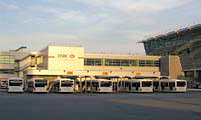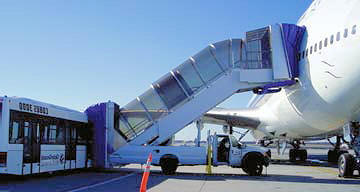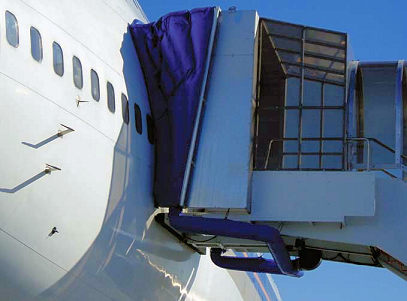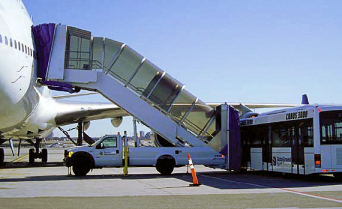JFK Fixes Gate Shortage with Hardstands
 Topping the list of capacity-constrained airports in the United States, John F. Kennedy International Airport (JFK) often lacks gate availability to meet the demand of its passenger aircraft flight schedules.
Topping the list of capacity-constrained airports in the United States, John F. Kennedy International Airport (JFK) often lacks gate availability to meet the demand of its passenger aircraft flight schedules.
So what is a solution-seeking airport operator to do?
Ditch the gates and warm up the bus, according to JFK International Air Terminal, LLC (JFKIAT) chief operating officer James L. Fazio.
 In lieu of investing in real estate development, JFKIAT increased Terminal 4's throughput by expanding its hardstand operation. With the delivery of two new Cobus 3000s in January, its hardstand inventory includes a fleet of eight buses, four stair trucks and a handicap lift, all of which accommodate 19 hardstand parking positions.
In lieu of investing in real estate development, JFKIAT increased Terminal 4's throughput by expanding its hardstand operation. With the delivery of two new Cobus 3000s in January, its hardstand inventory includes a fleet of eight buses, four stair trucks and a handicap lift, all of which accommodate 19 hardstand parking positions.
Hardstand History
The relatively inexpensive hardstand method of handling aircraft is common at major airports around the world, but is largely underutilized in North America. However, Terminal 4 is at the forefront of exploiting aircraft hardstands to add capacity and accommodate additional passenger aircraft during peak periods.
Fazio says hardstands were a staple of JFK's international operations even before JFKIAT assumed management in 1997.
"Back in the day, the Port Authority of New York and New Jersey had big mobile lounges that were used to facilitate hardstand operations," Fazio says of the evolving model. "We found we were spending a great deal of money maintaining these mobile lounges because nobody makes them and they are hard to support, so we decided to make a change over to buses."
JFKIAT initially purchased two Cobus 3000 airport buses in 2004, in addition to complementary AccessAir covered passenger stairs.
 "At the time, we didn't actually need them," Fazio says. "We weren't operating flights on hardstands at all, but we wanted the buses as an insurance policy; in case there was a mechanical delay or if there was inclement weather, we would have an alternative to gates and actually be able to offload an aircraft. Then, as the industry picked up, we found ourselves in a situation where the buses were getting used every day."
"At the time, we didn't actually need them," Fazio says. "We weren't operating flights on hardstands at all, but we wanted the buses as an insurance policy; in case there was a mechanical delay or if there was inclement weather, we would have an alternative to gates and actually be able to offload an aircraft. Then, as the industry picked up, we found ourselves in a situation where the buses were getting used every day."
Positive Results
With the measured growth of the operation, four more Cobus units were purchased in 2006, followed by two additional 3000 units this January. Cobus Industries president Don Frassetto says one of the main benefits of this type of remote operation is that it can expand very easily and as necessary.
"Last year, of the 8.9 million passengers and 55,000 flight operations conducted at Terminal 4, we handled just short of 4,000 flights with 400,000 passengers transported on the buses," Fazio says.
|
In addition to maximizing efforts during the 16:30 to 18:30 rush hour, the hardstand operation also helps JFKIAT fill off-peak operations and enlarge its carrier base. Gate planning dictates domestic carriers utilizing small Group III aircraft are the first flights to go to hardstand at the terminal. Most of Terminal 4's hardstands were designed for large international Group V aircraft, but a select few have been split into dual Group III parking positions to efficiently allow for two airplanes on one hardstand.
"From time to time when we exceed our gate capacity, there have been cases where we have put Virgin America on a hardstand," Fazio says, noting Sun Country and Northwest are also among the airlines that fall into that category. "Our ability to handle these operations with a bus operation has also helped us attain those airlines in the first place."
Although the hardstand operation is largely viewed as a positive, Fazio says domestic carriers initially resisted the change.
"The hardstand operation is typical to the foreign flag carriers," Fazio explains. "But here in the U.S., it is a very foreign operation. Interestingly enough, our gate plan calls for domestic flights to end up on hardstands first. They all resisted in the beginning, but the challenge for us was to do a good job with it and really make it as simple as possible."
 Tools of the Trade
Tools of the Trade
The challenge has been simplified through the use of purpose-built equipment designed specifically for JFKIAT's airside operations. AccessAir Systems president Guy Dostie says the self-propelled passenger airstairs APS60 model was developed with input from JFKIAT and COBUS, and is specifically designed to mate with both narrow and wide body aircraft as well as the COBUS apron bus to form a bridge between the aircraft and the ground. The AccessAir's sealed passenger cover and unique canopy system enable year-round use of hardstands by protecting passengers from inclement weather.
"The aircraft door opens up, people walk down steps, they get into a bus, and a few minutes later they are at the terminal," Fazio says. "Being able to deliver that day-in and day-out, problem-free, has been the biggest challenge for us, and over time we have been successful with that." 
2022 Charlotte Douglas International Airport Report of Achievement
 Giving back to the community is central to what Charlotte Douglas International Airport and its operator, the City of Charlotte Aviation Department, is about, and last year was no different.
Giving back to the community is central to what Charlotte Douglas International Airport and its operator, the City of Charlotte Aviation Department, is about, and last year was no different.
Throughout 2022, while recovering from the COVID-19 pandemic, we continued our efforts to have a positive impact on the Charlotte community. Of particular note, we spent the year sharing stories of how Connections Don't Just Happen at the Terminal - from creating homeownership and employment opportunities to supporting economic growth through small-business development and offering outreach programs to help residents understand the Airport better.
This whitepaper highlights the construction projects, initiatives, programs and events that validate Charlotte Douglas as a premier airport.
Download the whitepaper: 2022 Charlotte Douglas International Airport Report of Achievement.








